We've reached the penultimate episode of our Tarzan series. Now sailing into Disney wilds...
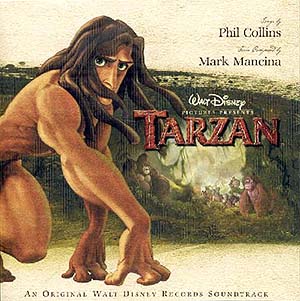 by Nathaniel R
by Nathaniel R
For over half a century in film and television storytellers didn't think Tarzan needed an origin plot but when the movies told it (Greystoke, 1984), it was as if everyone had always wanted to. Why not Disney then? Disney hadn't quite run out of classic fairytales to adapt by the mid-nineties but they were shifting their focus to boys. This was arguably due to their gargantuan back-to-back biggest-ever successes of Aladdin (1992) and The Lion King (1994), two animated features that deviated from their princess focus. Enter Hercules and then Tarzan. Neither were girly fairytales but both were still firmly embedded in fantasy and heightened enough for musical numbers.
Sort of.
By the time Tarzan rolled into town, Disney executives had clearly begun to wonder if audiences were done with the musical part of their Animated Musicals because Tarzan is only a musical in the sense that non-diegetic adult contemp ear worms keep popping up. They arrive without warning, with all the subtlety of a slasher movie jump scare.
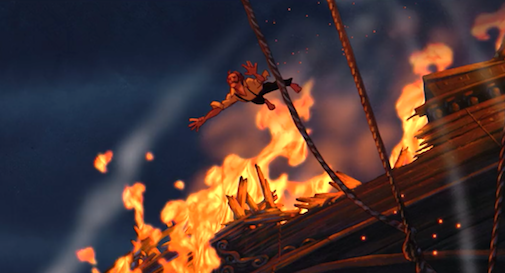 how many storms at sea / shipwrecks has Disney animated now? The number seems high.
how many storms at sea / shipwrecks has Disney animated now? The number seems high.
Tarzan begins with the shipwreck of the Greystokes (unnamed in the movie) and the ship has just barely exploded with fire nearly killing Papa Greystoke when Phil Collins is all "YOU'LL BE IN MY HEART..." (all caps intended) with a weird mix of soothing earnestness and anthemic bombast. It's quite distracting. Though Tarzan (1999) is the only Tarzan picture to ever win any Oscar (Best Original Song), the Oscar-winning part of it is nearly its biggest weakness.
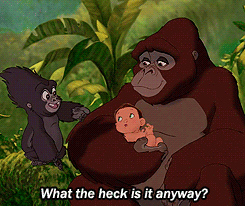 You know the origin story so Disney whizzes through it stopping in its tracks only for two things, comedy and parenting. The comedy comes by way of the film's other main weakness, Tarzan's sidekicks Terk (Rosie O'Donnell dialed up to an 11 when the film needs a 7 at best) and the elephant Tantor (Wayne Knight). This animal pair doesn't drag the movie down s much as the gargoyles in Hunchback of Notre Dame do but then the movie around them isn't vastly superior and tonally opposed to them as in the former case.
You know the origin story so Disney whizzes through it stopping in its tracks only for two things, comedy and parenting. The comedy comes by way of the film's other main weakness, Tarzan's sidekicks Terk (Rosie O'Donnell dialed up to an 11 when the film needs a 7 at best) and the elephant Tantor (Wayne Knight). This animal pair doesn't drag the movie down s much as the gargoyles in Hunchback of Notre Dame do but then the movie around them isn't vastly superior and tonally opposed to them as in the former case.
In the first act we also establish Tarzan's relationships with his defacto adoptive parents, the stern disapproving patriarch Kerchak (Lance Henriksen) and the kind maternal Kala. Kala is voiced by Glenn Close; in just fifteen years from 1984 to 1999 Glenn Close went from dubbing Tarzan's lover Jane (Greystoke) to dubbing his ape mom which is some kind of blatant "Hollywood is a Jungle for Actresses" metaphor.
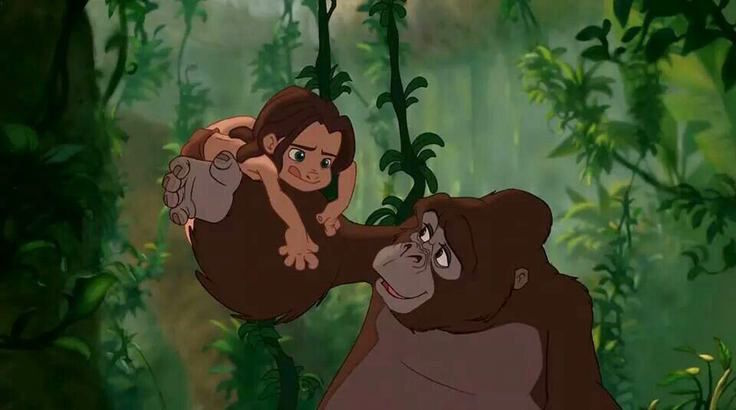
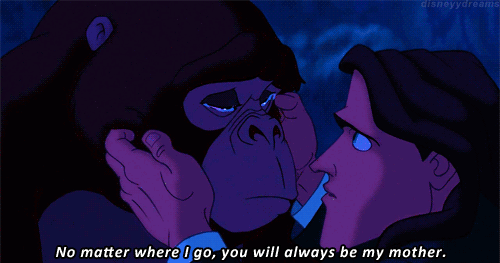
Still the Tarzan/Kala relationship almost makes the constant "You'll Be In My Heart" reprises bearable because it gives the movie its, well, heart. Or maybe it's that it's always a relief when you hear it and it's not Tarzan and Jane's song "Two Worlds"
It's not worth commenting on the film's villain Clayton except to say that its a weak effort for Disney (who often excel with villains) but par for the course with Tarzan films. As we've seen, the Tarzan franchise nearly always identify the villains immediately and never hides his or their evil even if Jane and her father have trouble seeing it -- this tradition goes all the way back to the Weismuller films. The only enormous misstep with the villain is calling him Clayton at all which is actually part of Tarzan's family name (John Clayton, Viscount Greystoke). Why muddy those waters for young viewers?
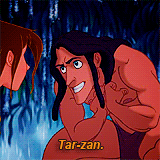 For all the unevenness of this particular Disney film, the film really finds its footing (so to speak) whenever Tarzan and Jane are paired and swinging around. Minnie Driver does terrific funny voicework as a proper British lady letting her hair down and Tarzan's slowed down movements and emotional responses/fascination in her presence are a pleasure to watch and a reminder of what we've lost with looser hand drawn animation. It's only a shame they don't let Minnie sing since her voice is more pleasant than Phil Collins's!
For all the unevenness of this particular Disney film, the film really finds its footing (so to speak) whenever Tarzan and Jane are paired and swinging around. Minnie Driver does terrific funny voicework as a proper British lady letting her hair down and Tarzan's slowed down movements and emotional responses/fascination in her presence are a pleasure to watch and a reminder of what we've lost with looser hand drawn animation. It's only a shame they don't let Minnie sing since her voice is more pleasant than Phil Collins's!
Tarzan films always reflect the era they're made in hard-to-miss ways so in this one that's all in Tarzan's physicality. He doesn't just swing from vines (the norm) but he surfs tree branches acrobatically and backwards like he's trying out tricks for the then newish and suddenly popular sport of snowboarding.
The smartest move is how Disney navigates the tricky terrain (for them) of lust at first sight with a nearly naked man. Tarzan has visible nipples and, more rare, visible abs with a telltale squiggly line, which seems like a first. He's showing off more thigh and side butt than any Tarzan since Buster Crabbe. Jane likes him right away but she's also (quite reasonably) scared. They cut the tension with comedy but the comedy springs organically from this very naked physicality, especially when Tarzan wants Jane to listen to his heart.
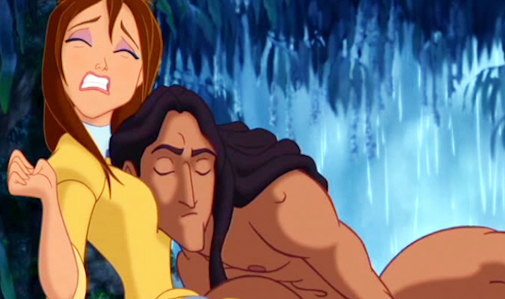
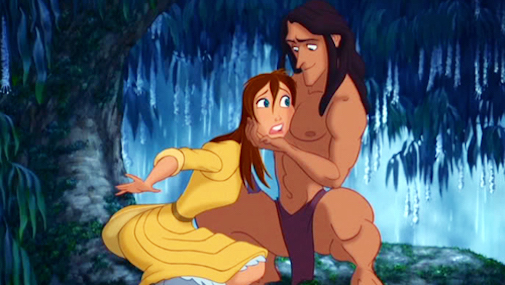 Tarzan doesn't know from personal boundaries - this is his first human interaction
Tarzan doesn't know from personal boundaries - this is his first human interaction
He doesn't know from personal space or consent, but he's also as innocent as a lamb. Jane's the one who finally makes the first move later in the film when she and her father decide to stay in the jungle. He's already in her heart, they're two worlds ---ARGH THESE SONGS! -- merging into one family.
Next Episode: The finale of our ten part miniseries as we revisit Alexander Skarsgård in The Legend of Tarzan (2016) now that the film has hit DVD and Blu-Ray
All Chapters:
Ch. 1 Buster Crabbe in Tarzan the Fearless (1933)
Ch. 2 Johnny Weissmuller & Maureen O'Sullivan in Tarzan and His Mate (1934)
Archive Extra: Tarzan the Ape Man (1932)
Ch. 3 Lex Barker in Tarzan's Peril (1951)
Ch. 4 Gordon Scott in Tarzan's Great Adventure (1959)
Ch. 5 Mike Henry in Tarzan and The Valley of Gold (1966)
Ch. 6 Bo Derek & Miles O'Keeffe in Tarzan the Ape Man (1980)
Ch. 7 Oscar loves Greystoke, The Legend of Tarzan: Lord of the Apes (1984)
Ch. 8 Casper Van Dien in Tarzan and the Lost City (1998)